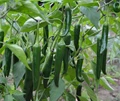
Chilies are the cornerstones of Indian dishes. The sharp fiery hit adds just the right taste to the food. Let us quickly look at some of the most popular chilies cultivated across India and delve into the secrets of their cultivation.
Chilies: The Regional Specialties
Kashmiri Chili: Hailing from the majestic Kashmir Valley, this chili is known for its deep red colour and surprisingly mild heat.
These are usually added for the vibrant hues to dishes like Rogan Josh and roasts. Cultivation in the cool Himalayan climate with well-drained, sandy loam soil allows these chilies to develop their signature colour and moderate spice level.
Guntur Sannam: Andhra Pradesh's Guntur district is the heartland of this fiery red chili. Relatively high on the Scoville scale (a measure of spiciness), Guntur chilies pack a punch.
They are typically dried and ground into powder, forming the base for the region's rich curries and chutneys. These chilies thrive in warm, dry climates with plenty of sunlight and well-drained soil. Farmers often cultivate them using raised beds so there is no obstruction during drainage.
Byadagi Chili: Karnataka's Byadagi chili is a versatile player. This moderately hot chili has a beautiful deep red tone, thin skin, and a smoky aroma.
They can be used both dried and powdered. Byadagi chilies prefer hot and dry climates with well-drained, sandy soil. Drip irrigation techniques are used to ensure a controlled water supply.
A Look at Regional Favorites
Jwala Chili: Grown primarily in Gujarat, the Jwala chili, also known as the "volcano pepper," lives up to its name. These small, green chilies are incredibly hot and are best used sparingly to add a fiery kick to chutneys and pickles. Jwala chilies thrive in warm, humid climates with fertile soil. They are grown using trellis support systems, allowing the plants to grow vertically and maximize space.
Bhut Jolokia (Ghost Pepper): This scorching chili, native to the Northeast of India, once held the Guinness World Record for the hottest pepper. The Bhut Jolokia is known for its beautiful orange colour. This variant is not typically eaten raw. These chilies require warm, humid climates with well-drained, fertile soil. Farmers often cultivate them using techniques similar to Jwala chilies.
Kanthari Mulaku: A true South Indian specialty, the Kanthari Mulaku from Kerala is small, green, and incredibly flavourful. While it packs a moderate heat, its defining characteristic is its unique citrusy aroma, making it a favorite for adding depth to curries and seafood dishes. These chilies thrive in warm, humid climates with well-drained, slightly acidic soil. They are cultivated using raised bed techniques.
From the fiery to the mildly spiced, each chili adds its magic to the vibrant tapestry of Indian cuisine.



















